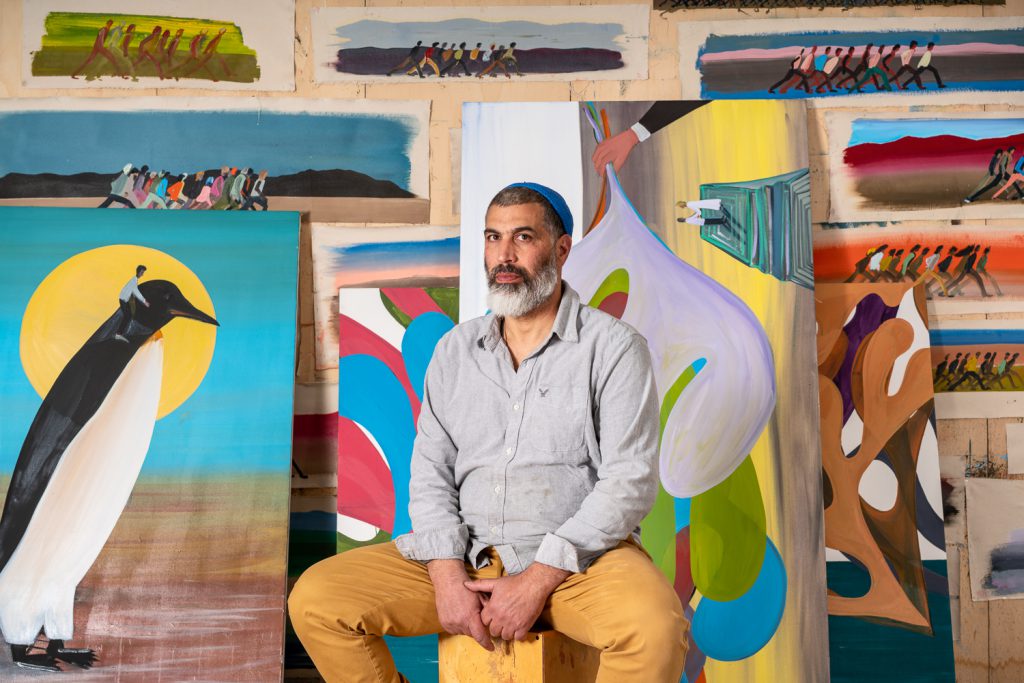After winning numerous awards and exhibiting his artworks in New York, London, Tokyo, Vienna, Chicago, Cleveland and Beijing, Shai Azoulay continues to work on his art and aims for more. The global pandemic didn’t slow him down, and these days he’s busy with press for his upcoming exhibition in Munich.

目次
Becoming an artist
Shai’s fascination with color and aesthetics started at a very young age.
“I remember myself as a child, walking in the field, collecting butterflies and putting them in a box. They didn’t always survive, but I thought they had an endless beauty. It was like art to me.”
In his early 20s, Shai traveled to Asia, always carrying a sketchbook with him. He attributes his decision to become an artist to one pivotal moment in his travels.
“I was on a beach in Thailand, sketching clothes hanging on a clothesline, and suddenly I just knew.”
At 25, he got accepted to Bezalel, the most prestigious art academy in Israel.
When he first started to paint, Shai found inspiration in his imagination, visions, and thoughts. Bezalel introduced him to different techniques, yet under their guidance Shai had to mostly paint from observation; it took him a long time to break free from the rules and norms he had studied.
”Eventually, I managed to go back to my origins and paint from my imagination while applying all the knowledge that I’ve learned. I think we all go through that. We learn something, forget it, and then find our way back to it.”

“It’s like the story ‘The Treasure Under the Bridge’ by Rabbi Nachman, he says. “You have a treasure hidden right under your nose, but you don't see it. After traveling very far in search of it, you realize that you had it all along.”
“I think it’s natural for artists to take their time.”
At 35 Shai had his big break and started presenting his work in big exhibitions. He considered it to be a late start, but it was important to him to start a family and take his time.
“I don’t want to follow the melancholic image of artists. I love going back to my kids and cooking for them. I think a true artist is able to devote himself to more than just art,” he says.
When an Israeli expedition brought curators to Israel, they stopped by Shai’s studio. The Japanese curator stayed back, asking to see more works. Then, he invited Shai to exhibit his art in a fair and in a gallery in Tokyo. This was one of Shai’s first international exhibitions.
“I was unsure if the Japanese people would connect with what I make, but it was simply amazing. People identified with my paintings and wanted to buy them. I realized that what I create isn’t Israeli just because I’m from Israel. It proved that art is a universal, visual language.”
“Going into the studio everyday is like entering your kingdom, though it doesn’t always work smoothly.”
For Shai, every day begins before sunrise. He wakes up to study Torah and then goes alone into the field to connect with God. This enables focus and allows a sense of guidance before going into the studio to work.

“My faith keeps me precise. Creation comes with ego, but when you’re a believer, you can laugh at yourself because creating is not the most important thing. It comes second to faith.”

“I don’t work with images. I imagine things and try to bring them into my paintings. The artistic process is turning thoughts, which are something very spiritual, into physical matter.”
When he has an idea, he starts with a small sketch, followed by a small study in oil. Only then, he begins working on the final, large oil painting.

“My paintings may seem childish and full of color, but I want this playful feeling, I want to tell a story. We’re in a world of conflict. A lot falls apart right in front of our eyes and we’re confused, especially now.”
“The pandemic made people question their life choices and seek out a purpose. Art can help people connect with themselves and focus on the good in life.”
Website




